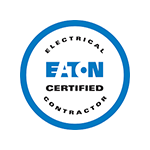The upgrade to a standby generator for your home will make a world of difference when the power has gone out. When you hire a professional electrician to install the generator, you get the major benefit of a company that follows strict guidelines and standards set forth by the United States Department of Energy.
Learn about the guidelines and safety measures that ensure your generator is installed safely and how following the protocols will protect your generator and home in the long run.
1. Generator Ground Element
A standby generator is typically installed in a permanent location on your property. Electricians will perform an inspection of the home’s exterior to find the ideal ground location for the installation.
Following the Department of Energy guidelines and expertise in the electric field, the generator should be properly grounded so a person does not experience electrical shocks or overloads from a generator not evenly placed on the ground.
A flat surface away from drainage areas like gutters is also ideal because a rise in groundwater could cause major issues for the generator. In some cases, a concrete slab or stone base may be necessary to help ground the generator and provide a stable base that rainwater can easily drain off of without puddling up.
2. Home Clearance Guidelines
Along with finding the proper ground area for the generator, guidelines also recommend a specific clearance away from the home. Keeping the generator away from homes is essential for preventing toxic fumes and carbon monoxide exposure. According to the Department of Energy, the generator should be at least 15 feet from the open structure of the home.
The open parts of a home include doors, windows, and basement openings. Electricians will use professional measurement tools to properly follow the guidelines and ensure the safety of the installation. In many cases, the electrician can find an area of the home with fewer windows, but if not, then you could consider putting the generator a little further away from the home.
You have the option to install a fenced-in area around the generator to help block off fumes and add extra protection to the home.
3. Automatic Transfer Switch
When a generator is installed to the main electric of your home, the installation must include an automatic transfer switch according to the Department of Energy. The switch will help the transfer of power between the electrical grid and the generator. When the power goes out, your generator will automatically kick on without any major power surges or glitches.
In many situations, your electronic devices will not even lose power as the transfer switch works instantly. The transfer switch is a preferred method over a portable generator, which cannot connect to the main power lines and is only useful for emergency situations.
4. Generator Inspections
After the generator installation is complete, electricians will perform a complete test and inspection of the generator. Power tests will ensure the transfer of power works correctly and your home doesn’t overload with surge issues. The inspection will also check the generator to ensure no cracks or leaks are present
The Department of Energy also recommends at least one maintenance service per year. You might easily forget about the generator when it’s not in use, so you should schedule the one-year visit on the day of the installation. You will help keep the generator running strong and kept clean for all your power needs.
Preventative care will save a lot of money in the long run and help increase the safety of the generator for your home.
Contact us at Oak Electric to set up your generator installation. Our experienced technicians have installed many generators and follow the Department of Energy guidelines to protect and ensure the safety of the generator installation.






















